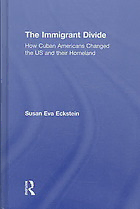
The immigrant divide : how Cuban Americans changed the US and their homeland PDF
Preview The immigrant divide : how Cuban Americans changed the US and their homeland
The Immigrant Divide Are all immigrants from the same country of origin best understood as one political and social group? Or are generational differences more profound than we might imagine? Between Castro’s rise to power in 1959 and the early twenty-first century more than a million Cubans immigrated to the United States. While it is widely known that Cuban émigrés have exerted a strong hold on Washington policy toward their homeland, Eckstein uncovers a fascinating paradox: the recent arrivals, although politically weak and poor, have done more to transform their homeland than the influential and prosperous early exiles who have tried for half a century to bring the Castro regime to heel. The impact of the so-called New Cubans is an unintended consequence of the personal ties they maintain with family in Cuba, ties the first arrivals oppose. This historically grounded, nuanced book offers a rare in-depth analysis of Cuban immigrants’ social, cultural, economic, and political adaptation, their trans- formation of Miami into the “northernmost Latin American city,” and their cross- border engagement and homeland impact. Eckstein accordingly provides new insight into the lives of Cuban immigrants, into Cuba in the post-Soviet era, and into how Washington’s failed Cuba policy might be improved. She also posits a new theory to deepen the understanding not merely of Cuban but of other immi- grant group adaptation. Susan Eva Eckstein is Professor of Sociology and International Relations at Boston University. Au thor of Back from the Future: Cuba under Castro, as well as numerous other books on Latin America, she is also former president of the Latin American Studies Association and the New England Council on Latin America. The Immigrant Divide How Cuban Americans Changed the US and their Homeland Susan Eva Eckstein First published 2009 by Routledge 270 Madison Ave, New York, NY 10016 Simultaneously published in the UK by Routledge 2 Park Square, Milton Park, Abingdon, Oxon OX14 4RN Routledge is an imprint of the Taylor & Francis Group, an informa business This edition published in the Taylor & Francis e-Library, 2009. To purchase your own copy of this or any of Taylor & Francis or Routledge’s collection of thousands of eBooks please go to www.eBookstore.tandf.co.uk. © 2009 Taylor & Francis All rights reserved. No part of this book may be reprinted or reproduced or utilized in any form or by any electronic, mechanical or other means, now known or hereafter invented, including photocopying and recording, or in any information storage or retrieval system, without permission in writing from the publishers. Trademark Notice: Product or corporate names may be trademarks or registered trademarks, and are used only for identification and explanation without intent to infringe. Library of Congress Cataloging in Publication Data Eckstein, Susan, 1942– The immigrant divide : how Cuban Americans changed the US and their homeland / Susan Eva Eckstein. p. cm. Includes bibliographical references. 1. Cuban Americans—History. 2. Cuban Americans—Social conditions. 3. Cuban A mericans—Politics and government. 4. Cuba— History—Revolution, 1959. 5. Cuba—Emigration and immigration. 6. Cuba—Foreign relations—United States. 7. United States—Politics and government. 8. United States—Emigration and immigration. 9. United States—Foreign relations—Cuba. I. Title. E184.C97E27 2009 973′.04687291—dc22 2009016639 ISBN 0-203-88100-1 Master e-book ISBN ISBN 10: 0–415–99922–7 (hbk) ISBN 10: 0–415–99923–5 (pbk) ISBN 10: 0–203–88100–1 (ebk) ISBN 13: 978–0–415–99922–9 (hbk) ISBN 13: 978–0–415–99923–6 (pbk) ISBN 13: 978–0–203–88100–2 (ebk) In memory of Maggie Contents List of Figures and Tables ix Acknowledgments xi Introduction 1 1 Immigrants and the Weight of Their Past 10 2 Immigrant Imprint in America 40 3 Immigrant Politics: For Whom and for What? 88 4 The Personal is Political: Bonding Across Borders 127 5 Cuba Through the Looking Glass 153 6 Transforming Transnational Ties into Economic Worth 178 7 Dollarization and its Discontents: Homeland Impact of Diaspora Generosity 207 8 Reenvisioning Immigration 229 Appendix: Field Research 239 Notes 245 Bibliography 269 Index 289 List of Figures and Tables Figures 1.1 Immigrants officially admitted to the US by country of origin, 1951–2004 11 4.1 Cuban-American travel to Cuba, 1990–2004 133 Tables 1.1 Cuban occupational structure and last job held in Cuba by émigrés to the US 16 1.2 Race, gender, and age-of-immigration among Cuban Americans in Miami and nationwide in census years 1970–2000 19 1.3 Cuban Americans in 2000: Percentage US and foreign-born (by year of entry) 33 2.1 Residence of Cuban Americans in census years 1970–2000 46 2.2 Racial and ethnic composition of Miami in census years 1970–2000 46 2.3 Co-ethnic sociability in Miami among Cuban Americans in 2004 48 2.4 Cuban American linguistic acculturation in Miami in 2004 and 2007 52 2.5 Job and income attainment among Cuban Americans in Miami in census years 1970–2000 71 2.6 Job attainment by age among Cuban Americans in Miami in census years 1970–2000 75 2.7 Income by age among Cuban Americans in and outside Miami in census years 1970–2000 76 2.8 Job attainment by age-of-immigration among Cuban Americans in census years 1970–2000 77 2.9 Income by age-of-immigration in and outside Miami in census years 1970–2000 78
